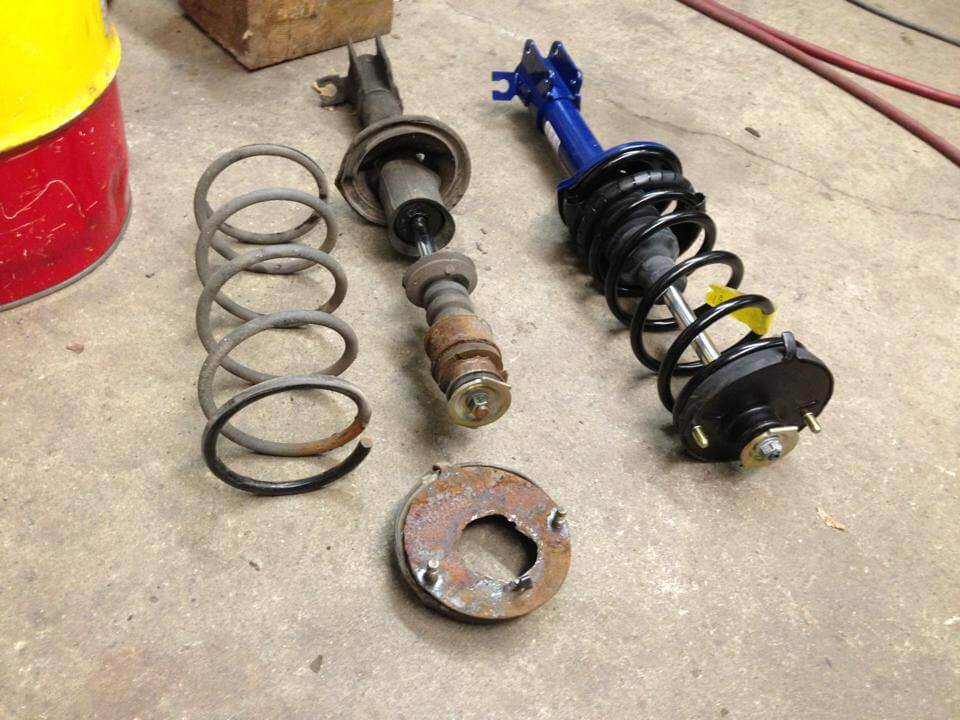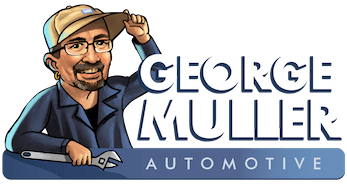Steering, suspension, & alignment are all intertwined with each other. The suspension and alignment of your vehicle directly affects the handling & steering of your vehicle, so we’ll talk a little bit on this page about the dynamics of their relationship.

This customer had an odd clunk from his rear suspension. As you can see here, the strut mount had rusted through and the strut was leaking badly. I installed a new strut assembly and the car drives like new.
What Does Your Vehicle’s Suspension Mean To You, The Driver?
Every car has front and rear suspension. Your car’s suspension is what’s between the wheels and chassis of the car. It keeps you running straight down the road, regardless of how bumpy or crooked that road is.
If parts are misaligned or worn-out, it will negatively affect the handling of the vehicle, increase tire wear, and lower mileage.
Symptoms Of Suspension Problems
Here are some of the most common things that you would experience if you had a suspension problem:
- vehicle leans to the left or right
- vehicle feels “swimmy”, very similar to what a flat tire feels like
- unusual noises coming from the vehicle (eg. creaking, clunking, rubbing, squawking sounds when you go over bumps)
- it won’t feel right when you go over bumpy or wavy roads
- you hit a bump, and it feels like the car is jumping to the left or the right
Diagnosing Suspension Problems
Some suspension problems are quite easy to diagnose, while others are more difficult, especially when you’re dealing with a combination of different components.
An example would be a strut assembly, where you have a shock, a spring, a mount, and a thrust washer for turning that are all built into one unit. Any one of these components can cause a problem, and sometimes the assembly needs to be taken apart to confirm which component is at fault.
I always start by looking for components that have excess play in them (parts that move when they shouldn’t move). Harder to diagnose problems are when the parts don’t have any play, but are still causing a problem. Those parts may need to be taken apart to troubleshoot the issue.
“Which Types Of Suspension Parts Should I Buy?”
The quality of suspension parts varies greatly, and cheap parts can wear out quickly, requiring you to do the same job twice.
Most of the parts I use are a premium quality, and many of them have lifetime warranties. I don’t use “performance” parts though. Why?
Many “performance” parts sacrifice ride quality and comfort for handling, because they’re meant for people who are racing. The racer wants to corner hard and grip the road at all costs; he doesn’t care if he feels every bump in the road. On top of that, performance parts may not even last longer than their premium counter-parts, so they’re not the best option for an average daily driver.
If you’re a performance enthusiast, I can still purchase and install your performance parts, but an average driver simply doesn’t need the “performance” option.
I’m fully capable of dealing in both styles of repair: the daily driver, and the performance enthusiast.
The Cost Of Repairing Your Suspension
Suspension repair costs can have a large range, because there are lots of components in a suspension system.
If one of your outer tie-rod ends wears out, it could cost as little as $100 to replace. But if your struts are worn out, it could easily exceed $500+. For this reason, it’s always important to make sure you’re replacing only what’s necessary; this saves money – nothing worse than throwing good parts away!
Some shops like to replace everything, that way they’re guaranteed to fix it (even if it costs you more). It takes discretion and careful thought to keep repairs to a minimum.
Alignments
A lot of steering and suspension components have adjustments built into them, so that they can be lined up properly to calibrate your steering. A well calibrated vehicle should drive straight, handle well, and feel good to drive.
I don’t do alignments at my shop, but if you need your steering aligned, I recommend that you visit Green Acres Alignment & Automotive in Chilliwack. I personally use and trust them for customer vehicles, and on my own vehicles (including my 1960 Pontiac Laurentian).
Alignments there typically cost around $100.
